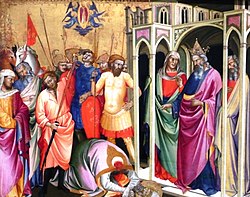Pontificate

Christian tradition makes Caius a native of the Dalmatian city of Salona, the son of a man also named Caius or Gaius, and a member of a noble family related to the Emperor Diocletian. [5] About 280, an early Christian house of worship was established on the site of Santa Susanna, which, like many of the earliest Christian meeting places, was in a house (domus ecclesiae). The domus belonged, according to the sixth-century acta , to brothers named Caius and Gabinus, prominent Christians. Caius may be this pope, or Caius the Presbyter. Gabinus is the name given to the father of Susanna. Thus, sources state that Caius was the uncle of Susanna. [1]
As pope, Caius decreed that before someone could assume the position of bishop, he must first be porter, lector, exorcist, acolyte, subdeacon, deacon, and priest. He also divided the districts of Rome among the deacons. [4] [6] During his pontificate, anti-Christian measures increased, although new churches were built and cemeteries were expanded. [5] [4]
Martyrdom
Pope Caius would go into hiding due to increased persecution of the church, alongside Saints Polycarp, Sebastian, Tranquillinus, Tiburtius, Nicostratus and Zoe, in the house of Castulus, a Christian officer employed at the Imperial Palace. [7] Over the course of the next few years, the entire group would be discovered one by one by Roman authorities and martyred. [7] Caius would be found praying with Tiburtius shortly after the conversion and baptism of Tiburtius' children and the pair was brought to the local Praefectus, a man named Fabian, who ordered the construction of a great bonfire, and ordered the two to either throw frankincense into it to appease the Roman gods, or to cast themselves into it. [7] Although Pope Caius' ultimate fate is unclear, often being associated with beheading, according to legend Tiburtius walked into the fire invoking the name of Christ and remained unhurt, so he was taken out of Rome by the Via Labicana and beheaded. [7] However, Caius' martyrdom is disputed, as the Diocletianic Persecution of Christians began in 303 AD, after Caius’ alleged death, and Diocletian was not immediately hostile to Christianity upon becoming emperor. [5] [4]
